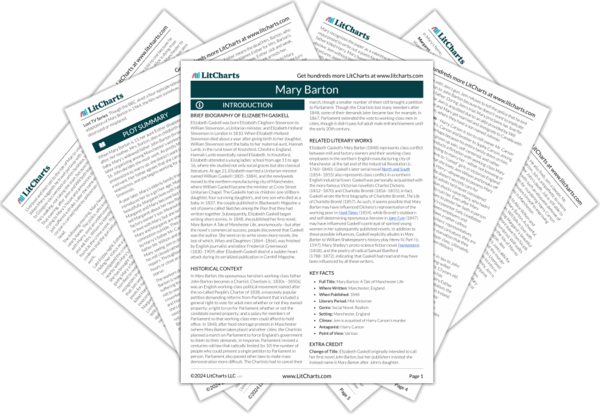Mary Barton represents sexuality as fundamentally dangerous—especially to women, but also to working-class men. The novel opens with a discussion of Esther, a young factory worker who has disappeared from her lodging house. Her brother-in-law John Barton immediately assumes that Esther has become embroiled in a premarital romance and will likely end up a sex worker. Subsequent revelations prove him right: Esther has eloped with an army officer who has promised to marry her. He fails to make good on his promise, impregnates her anyway, and eventually abandons her when the army stations him overseas. As a working-class woman with limited economic opportunities and no access to free childcare, Esther is eventually forced into sex work. Then her baby dies, and she becomes an alcoholic to deal with her grief and shame. Esther’s tragic story hammers home that any premarital sexual activity came with extreme risk in the 19th century, especially for working-class women. Moreover, later events in the novel suggest that sexuality is dangerous not only to young working-class women but to the working-class men around them. After John’s daughter Mary Barton engages in a brief flirtation with the pushy manufacturing heir Harry Carson, her working-class suitor (and eventual true love) Jem Wilson is arrested and nearly executed on circumstantial evidence for Harry’s murder. Many characters around Mary blame her flirtatiousness for Jem’s near execution, suggesting that in this society, flirtation itself can put disenfranchised people in harm’s way. And even though Harry’s murder in fact had nothing to do with his pursuit of Mary, the narrative does seem to hint that if working-class women stray from strict sexual propriety under these societal circumstances, it might impel working-class men to desperate acts or put them in legal danger through no fault of their own. Thus, the novel makes the (now quite dated) implication that any premarital sexuality is a threat not only to people’s souls but to their very lives.
Sexuality and Danger ThemeTracker

Sexuality and Danger Quotes in Mary Barton
“Not but what beauty is a sad snare. Here was Esther so puffed up that there was no holding her in.”
So with this consciousness she had early determined that her beauty should make her a lady; the rank she coveted the more for her father’s abuse; the rank at which she firmly believed her lost Aunt Esther had arrived.
“Tell me, Margaret,” said Mary, taking her apron down from her eyes, and looking at Margaret with eager anxiety, “what can I do to bring him back to me? Should I write to him?”
“No,” replied her friend, “that would not do. Men are so queer, they like to have a’ the courting to themselves.”
“How can I keep her from being such a one as I am; such a wretched, loathsome creature! She was listening just as I listened, and loving just as I loved, and the end will be just like my end. How shall I save her?”
What were these hollow vanities to her, now that she had discovered the passionate secret of her soul? She felt as if she almost hated Mr Carson, who had decoyed her with his baubles. […] She had hitherto been walking in grope-light toward a precipice; but in the clear revelation of that past hour she saw her danger, and turned away resolutely and for ever.
For, be it remembered, she had the innocence, or the ignorance, to believe his intentions honourable; and he, feeling that at any price he must have her, only that he would obtain her as cheaply as he could, had never undeceived her[.]
To whom shall the outcast prostitute tell her tale? Who will give her help in the day of need? Hers is a leper sin, and all stand aloof dreading to be counted unclean.
The corner of stiff, shining, thick, writing paper she recognised as a part of the sheet on which she had copied Samuel Bamford’s beautiful lines so many months ago—copied (as you perhaps remember) on the blank part of a valentine sent to her by Jem Wilson, in those days when she did not treasure and hoard up everything he had touched, as she would do now.
Gentle, reserved, and prudent herself, never exposed to the trial of being admired for her personal appearance […] Margaret had no sympathy with the temptations to which loveliness, vanity, ambition, or the desire of being admired exposes so many; no sympathy with flirting girls, in short. Then, she had no idea of the strength of conflict between will and principle in some who were differently constituted from herself.
“I almost misdoubt thee, thou’rt so pretty. Well-a-well! It’s the bad ones as have the broken hearts, sure enough; good folk never get utterly cast down, they’ve always getten hope in the Lord; it’s the sinful as bear the bitter, bitter grief in their crushed hearts, poor souls; it’s them we ought, most of all, to pity and help.”
“You’ve set up heroine on your own account, Mary Barton. How did you like standing witness?”











